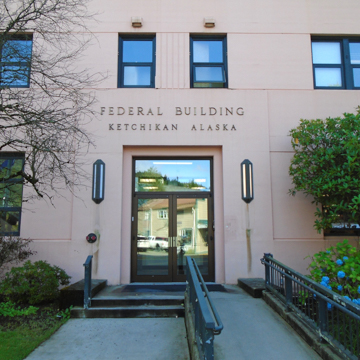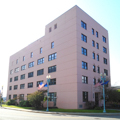Built on landfill, Ketchikan's Federal Building is an unusually vertical version of 1930s government architecture in Alaska. The Cleveland, Ohio, architectural firm of Garfield, Stanley-Brown, Harris, and Robinson designed a terracotta-embellished, semi-hexagonal building in 1933. When construction bids exceeded the allotted amount, the firm redesigned, ending up with this five-story, reinforced concrete building. Construction of the 50-foot-by-117-foot building, with a one-story 49-foot-by-51-foot section on one side, was begun in 1937 and completed one year later for $326,000. The concrete on the exterior is smooth finished and unornamented, except for horizontal lines at the levels of sills and lintels and vertical lines between windows, characteristic of the austere style of the federal buildings in frontier Alaska. The building housed the post office, courthouse, customhouse, and jail. Today the visitors' center of the U.S. Forest Service occupies the first floor, with offices and courtrooms above.
You are here
Federal Building
If SAH Archipedia has been useful to you, please consider supporting it.
SAH Archipedia tells the story of the United States through its buildings, landscapes, and cities. This freely available resource empowers the public with authoritative knowledge that deepens their understanding and appreciation of the built environment. But the Society of Architectural Historians, which created SAH Archipedia with University of Virginia Press, needs your support to maintain the high-caliber research, writing, photography, cartography, editing, design, and programming that make SAH Archipedia a trusted online resource available to all who value the history of place, heritage tourism, and learning.




